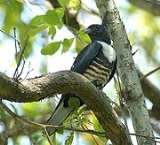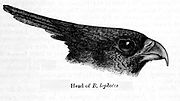
Black Baza
Encyclopedia
The Black Baza is a small sized bird of prey
found in the forests of South Asia
and Southeast Asia
. Many populations are migratory. The races in the Indian region are migratory, wintering in the south of the Peninsula and Sri Lanka. The Black Bazas have short, stout legs and feet with strong talons. A prominent crest is a feature of the Bazas. They are found in dense forest often in small groups. They are also known to spend a lot of time perching on open perches overlooking forest canopy.
 The Black Baza is a small and distinctively coloured raptor. When perched, the upright crest and contrasting patterns make it difficult to misidentify. The male has white scapulars, secondary coverts and on the secondaries. The female has white only on the scapulars and more chestnut bands on the underside unlike the few bands in the male. In flight it is crow like and is often seen in small groups or flocks during migration. During migration, they are gregarious at their roost. They are somewhat crepuscular and more active at dusk and in overcast weather.
The Black Baza is a small and distinctively coloured raptor. When perched, the upright crest and contrasting patterns make it difficult to misidentify. The male has white scapulars, secondary coverts and on the secondaries. The female has white only on the scapulars and more chestnut bands on the underside unlike the few bands in the male. In flight it is crow like and is often seen in small groups or flocks during migration. During migration, they are gregarious at their roost. They are somewhat crepuscular and more active at dusk and in overcast weather.
They feed mainly on insects by making aerial sallies. They may also pick insects off a leaf, the insects always seized with their feet. They have been observed to attempt capturing small birds such as wagtails by making dashes into flocks. They have been noted to join mixed-species foraging flocks. It has also been known to feed on the fruits of the oil palm. They are somewhat crepuscular in habit. The call is a "chu-weep" somewhat similar to the call of the Large Cuckoo-shrike
. Other descriptions include a soft squeal or whistle and a shrill gull-like mewing.
Like others in the genus Aviceda they have two tooth like indentations on the edge of the upper bill. Birds are said to have a disagreeable odour which has been said to be "bug-like".
 The bird was first described based on a specimen from Pondicherry under the name of Falco leuphotes. Several geographic races have been described including wolfei which is based on a single specimen from Sichuan and may belong to the nominate subspecies. The named forms include the following but have been questioned: and further study has been called for
The bird was first described based on a specimen from Pondicherry under the name of Falco leuphotes. Several geographic races have been described including wolfei which is based on a single specimen from Sichuan and may belong to the nominate subspecies. The named forms include the following but have been questioned: and further study has been called for
In southern India the species is regularly reported in winter mainly from the Western Ghats
(breeding records have been questioned), Eastern Ghats
(mainly on spring passage) and known to breed in northeastern India and Burma. Winter records of the species include stray occurrences in or near metropolitan areas such as the Guindy National Park
in Chennai
, near Trivandrum and Bangalore
. More recent studies have suggested that the species may be a regular winter visitor in the eastern part of peninsular India, and not just a passage migrant. Individuals have also been noted at Point Calimere.
The birds in northeastern India begin to breed in April. Both sexes take part in nest building, incubation, brooding and feeding. The nest is a firm platform of thin sticks with a central depression and lined with grass, fiber and overlaid with green leaves. The eggs take about 26–27 days to hatch. Insects are the predominant food of the chicks.
Bird of prey
Birds of prey are birds that hunt for food primarily on the wing, using their keen senses, especially vision. They are defined as birds that primarily hunt vertebrates, including other birds. Their talons and beaks tend to be relatively large, powerful and adapted for tearing and/or piercing flesh....
found in the forests of South Asia
South Asia
South Asia, also known as Southern Asia, is the southern region of the Asian continent, which comprises the sub-Himalayan countries and, for some authorities , also includes the adjoining countries to the west and the east...
and Southeast Asia
Southeast Asia
Southeast Asia, South-East Asia, South East Asia or Southeastern Asia is a subregion of Asia, consisting of the countries that are geographically south of China, east of India, west of New Guinea and north of Australia. The region lies on the intersection of geological plates, with heavy seismic...
. Many populations are migratory. The races in the Indian region are migratory, wintering in the south of the Peninsula and Sri Lanka. The Black Bazas have short, stout legs and feet with strong talons. A prominent crest is a feature of the Bazas. They are found in dense forest often in small groups. They are also known to spend a lot of time perching on open perches overlooking forest canopy.
Description

They feed mainly on insects by making aerial sallies. They may also pick insects off a leaf, the insects always seized with their feet. They have been observed to attempt capturing small birds such as wagtails by making dashes into flocks. They have been noted to join mixed-species foraging flocks. It has also been known to feed on the fruits of the oil palm. They are somewhat crepuscular in habit. The call is a "chu-weep" somewhat similar to the call of the Large Cuckoo-shrike
Large Cuckoo-shrike
The Large Cuckoo-shrike Coracina macei is a species of cuckooshrike found in south and south east Asia. They are mostly insectivorous and usually fly just above the forest canopy. They have a loud call Klu-eep and have a characteristic habit of shrugging their closed wings shortly after landing on...
. Other descriptions include a soft squeal or whistle and a shrill gull-like mewing.
Like others in the genus Aviceda they have two tooth like indentations on the edge of the upper bill. Birds are said to have a disagreeable odour which has been said to be "bug-like".
Taxonomy and systematics

- syama (Hodgson, 1837) from eastern Nepal, northeastern India to south China which winters in Indo-China and the Malaya Peninsula
- leuphotes (Dumont, 1820) (said to breed in SW India but evidence questioned by Rasmussen and Anderton (2005)) is said to breed in Burma and Thailand but those may actually be the same as syama although the population in this region has in the past been assigned the name of burmana
- andamanica Abdulali & Grubh, 1970 is endemic to the Andaman Islands (South Andaman I) and has completely white underparts lacking any chestnut bands
Distribution
This species is found in Southeast Asia and parts of South Asia. They are migratory in parts of their range. Migratory birds may be seen in large numbers at some locations such as Chumphon in Thailand where they account for nearly 40% of the raptors on passage. In some parts of Hong Kong, they have established themselves in recent times changing from summer visitors to residents in small numbers.In southern India the species is regularly reported in winter mainly from the Western Ghats
Western Ghats
The Western Ghats, Western Ghauts or the Sahyādri is a mountain range along the western side of India. It runs north to south along the western edge of the Deccan Plateau, and separates the plateau from a narrow coastal plain along the Arabian Sea. The Western Ghats block rainfall to the Deccan...
(breeding records have been questioned), Eastern Ghats
Eastern Ghats
The Eastern Ghats or Eastern Ghauts are a discontinuous range of mountains along India's eastern coast. The Eastern Ghats run from West Bengal state in the north, through Orissa and Andhra Pradesh to Tamil Nadu in the south passing some parts of Karnataka. They are eroded and cut through by the...
(mainly on spring passage) and known to breed in northeastern India and Burma. Winter records of the species include stray occurrences in or near metropolitan areas such as the Guindy National Park
Guindy National Park
Guindy National Park is a Protected area of Tamil Nadu, located in Chennai, South India, is the 8th smallest National Park of India and one of the very few national parks situated inside a city. The park is an extension of the grounds surrounding Raj Bhavan, formerly known as the 'Guindy Lodge',...
in Chennai
Chennai
Chennai , formerly known as Madras or Madarasapatinam , is the capital city of the Indian state of Tamil Nadu, located on the Coromandel Coast off the Bay of Bengal. Chennai is the fourth most populous metropolitan area and the sixth most populous city in India...
, near Trivandrum and Bangalore
Bangalore
Bengaluru , formerly called Bengaluru is the capital of the Indian state of Karnataka. Bangalore is nicknamed the Garden City and was once called a pensioner's paradise. Located on the Deccan Plateau in the south-eastern part of Karnataka, Bangalore is India's third most populous city and...
. More recent studies have suggested that the species may be a regular winter visitor in the eastern part of peninsular India, and not just a passage migrant. Individuals have also been noted at Point Calimere.
The birds in northeastern India begin to breed in April. Both sexes take part in nest building, incubation, brooding and feeding. The nest is a firm platform of thin sticks with a central depression and lined with grass, fiber and overlaid with green leaves. The eggs take about 26–27 days to hatch. Insects are the predominant food of the chicks.
Other sources
- Hussain,SA (1985) Comments on Mr Abdulali's note on Dr. Sugathan's paper on Avifauna of Point Calimere. J. Bombay Nat. Hist. Soc. 82(1):210-212.
- Inglis,CM (1948) Plumage of the young of the Indian Black-crested Baza. Jour. Bengal Nat. Hist. Soc. 23(1):73-75.

